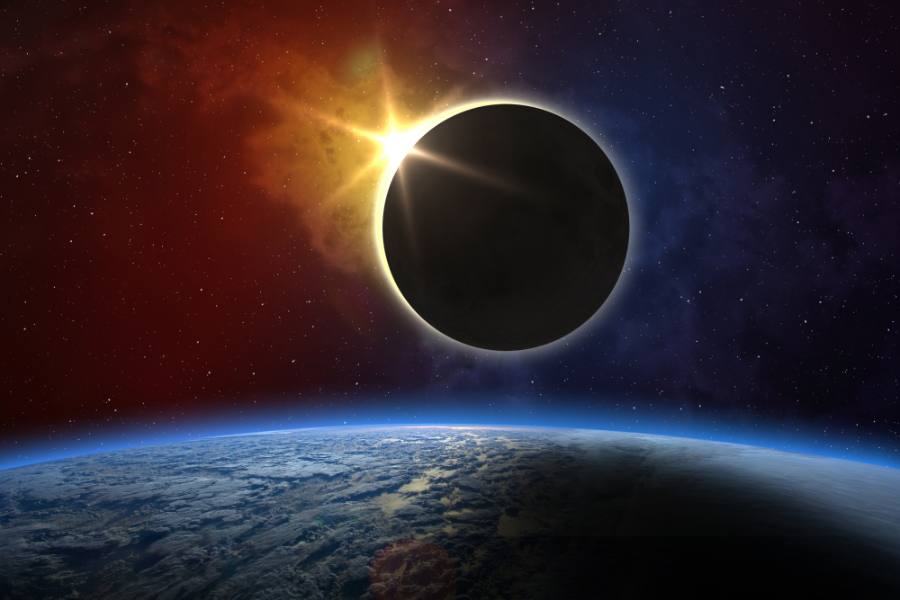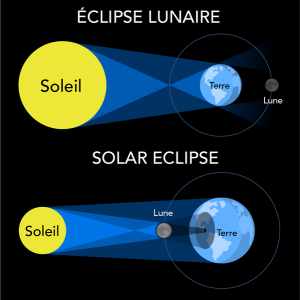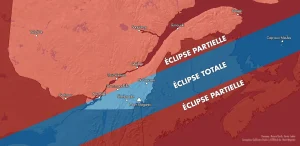Eclipse 2024

A spectacular and extremely rare cosmic phenomenon will take place on the afternoon of Monday, April 8, 2024… A total solar eclipse! The eclipse will be visible from most of North America. However, one region in particular, known as the path of totality, will be treated to the particularly rare and spectacular total phase of the eclipse. And the Mont-Mégantic Observatory is right in the middle of this path of totality!
What is an eclipse?
In its broadest sense, an eclipse is an astronomical phenomenon that occurs when a celestial object hides another celestial object in space from the view of an observer. For us humans, this implies an alignment between the Earth, the Moon, and the Sun.
During a lunar eclipse, visible during the night and quite frequent, the Earth finds itself between the Sun and the Moon. Since the Moon shines mainly by reflecting the Sun’s light, it appears darker when the Earth blocks this light. During a total lunar eclipse, the Moon takes on a reddish appearance (blood moon). This is caused by a phenomenon related to atmospheric refraction.

A diagram explaining the difference between a lunar eclipse (top) and a solar eclipse (bottom). (Credit: Getty Images/in8finity, adapted by Let’s Talk Science!)
During a solar eclipse, visible during the day for only part of the Earth’s population at any one time, the Moon comes between the Sun and the Earth. The Moon blocks the Sun and casts a shadow on the Earth’s surface. During a total eclipse, the Moon completely blocks out the Sun for a period of a few minutes, known as totality.
Are eclipses rare?
Since the celestial objects involved in our eclipses move in well-understood orbits, these phenomena recur at predictable, but not absolutely constant, intervals. While eclipses occur every year on Earth in general, they are much rarer for a specific location on the planet’s surface!
The last total solar eclipse visible in Quebec was in 1972. The last one visible in southern Quebec was in 1963. If you’re planning to miss the eclipse on April 8, 2024, and see the next one visible in southern Quebec, you’ll have to wait until… 2106!
When and where can I observe the eclipse on April 8, 2024?

A map of southern Quebec showing the regions where the solar eclipse on April 8, 2024 will be partial and total. (Credit: G. Poulin/ASTROLab du Mont-Mégantic)
A 99% partial eclipse is a completely different experience from a total solar eclipse. It’s not 99% as good! We therefore strongly recommend, if possible, that you find your way to the path of totality to enjoy this incredible phenomenon.
The start and end times of each phase of the eclipse will be slightly different depending on your location. At the Mont-Mégantic, the partial eclipse will begin at 2:18 pm. Totality will take place between 3:28 pm and 3:32 p.m. These 3 minutes and 28 seconds may seem short, but they will be a life-changing moment for spectators! The partial eclipse will end at 4:39 pm. To find out approximate times for your location, visit the Éclipse Québec website.
For public safety reasons, access to the summit of Mont-Mégantic will be highly restricted during the solar eclipse on April 8, 2024. We cannot accommodate requests for public access on this day. Our friends at the Mont-Mégantic ASTROLab are organising a public event at the foot of the mountain, which requires the purchase of tickets. A number of events and gatherings will be taking place throughout southern Quebec, so you can experience this cosmic spectacle with other space enthusiasts!
How can I observe the eclipse on April 8, 2024?

A composite image showing the different phases of a total solar eclipse. Only the phase of totality (centre image) can be safely observed with the naked eye. (Credit: Justin Ng)
We can afford to repeat the old adage again… Never look directly at the Sun! The only exception to this golden rule is during the TOTAL phase of a solar eclipse. During this brief moment, and ONLY this moment, you can look at the directly Sun with your naked eye without hurting your eyes.
At all other times, it’s essential to use specialised equipment that blocks the vast majority of the Sun’s light, allowing you to observe it safely. The tool of choice during a solar eclipse is a pair of eclipse glasses. A normal pair of sunglasses is not adequate protection! It’s very important to ensure that your eclipse glasses come from a reliable, compliant manufacturer, and that they are certified with the ISO 12312-2 mark. Eclipse glasses are already a rare commodity, so get your pair quickly! You’ll find a list of selected outlets on the Éclipse Québec website.
It’s also possible to observe a solar eclipse indirectly, by projection. Basically, you need two surfaces: one to serve as an observation screen, and the other to drill a tiny hole, a pinhole, through which only a few rays of light can pass. The famous shoebox is an example of indirect observation. The classic support is a shoebox or cereal box, but even simpler methods can be employed, as long as they follow the right basic principle. Building a solar observation box can be a fun, creative and scientific activity. Follow the instructions on the Canadian Space Agency website!
For more information
- Éclipse Québec website
- Eclipse website of the Université de Montréal
- The video series “E comme Éclipse”, created by the Trottier Institute for Research on Exoplanets
- Educational resources developed for teachers (in English and French) created by Discover the Universe
- A list of suggested reads for the young and young at heart about the Moon, the Sun, the Earth, eclipses, and astronomy compiled by the Trottier Institute for Research on Exoplanets
